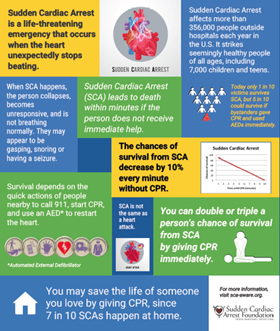We Can Reduce Mortality through Awareness and Bystander Interventions
Sudden cardiac arrest is the leading cause of death in the United States, taking the lives of more than 356,000 people every year. It strikes seemingly healthy people of all ages, even children and teens. In 95% of cases, the victim is lost.
Most cases of sudden cardiac arrest occur outside of hospitals. It happens most often in a home or residence (68.5%), followed by public settings (21%) and nursing homes (10.5%), according to the Centers for Disease Control and Prevention.
The need to raise awareness about sudden cardiac arrest is critical. People need to be educated about prevention strategies and how to take immediate action in the case of a cardiac emergency.
Sudden cardiac arrest is not a heart attack, which is caused by impeded blood flow through the heart.
Sudden cardiac arrest can result from cardiac causes (abnormalities of the heart muscle or the heart's electrical system), external causes (drowning, trauma, asphyxia, electrocution, drug overdose, blows to the chest), and other medical causes such as inflammation of the heart muscle due to infection.
Cardiac arrest is a public health issue with widespread incidence
and severe impact on human health and well-being.
Early warning signs of sudden cardiac arrest may include fatigue, fainting, blackouts, dizziness, chest pain, shortness of breath, weakness, palpitations or vomiting. But it often occurs with no warning at all.
When sudden cardiac arrest happens, the victim collapses, becomes unresponsive, and is not breathing normally. They may appear to be gasping, choking, or having a seizure.
To survive sudden cardiac arrest, the victim must receive life-saving defibrillation from an automated external defibrillator (AED) within the first four to six minutes.
Every minute that passes without a shock from an AED decreases the chance of survival by 10%. Administering hands-only cardiopulmonary resuscitation (CPR) can be a bridge to life until an AED arrives.
AEDs — increasingly available in public places and homes — are designed for use by laypersons, and provide visual and voice prompts. They will not shock the heart unless shocks are needed to restore a healthy heartbeat.
The survival rate has remained stagnant for three decades because people outside of hospitals aren't as prepared as they should be to save a life.
The estimated burden to society of death from cardiac arrest is 2 million years of life lost for men and 1.3 million years for women, greater than estimates for all individual cancers and most leading causes of death.
Take-Away Message: You can save a life. First, be prepared. Learn CPR and how to use an AED. Then, here's what to do if sudden cardiac arrest strikes:
|


